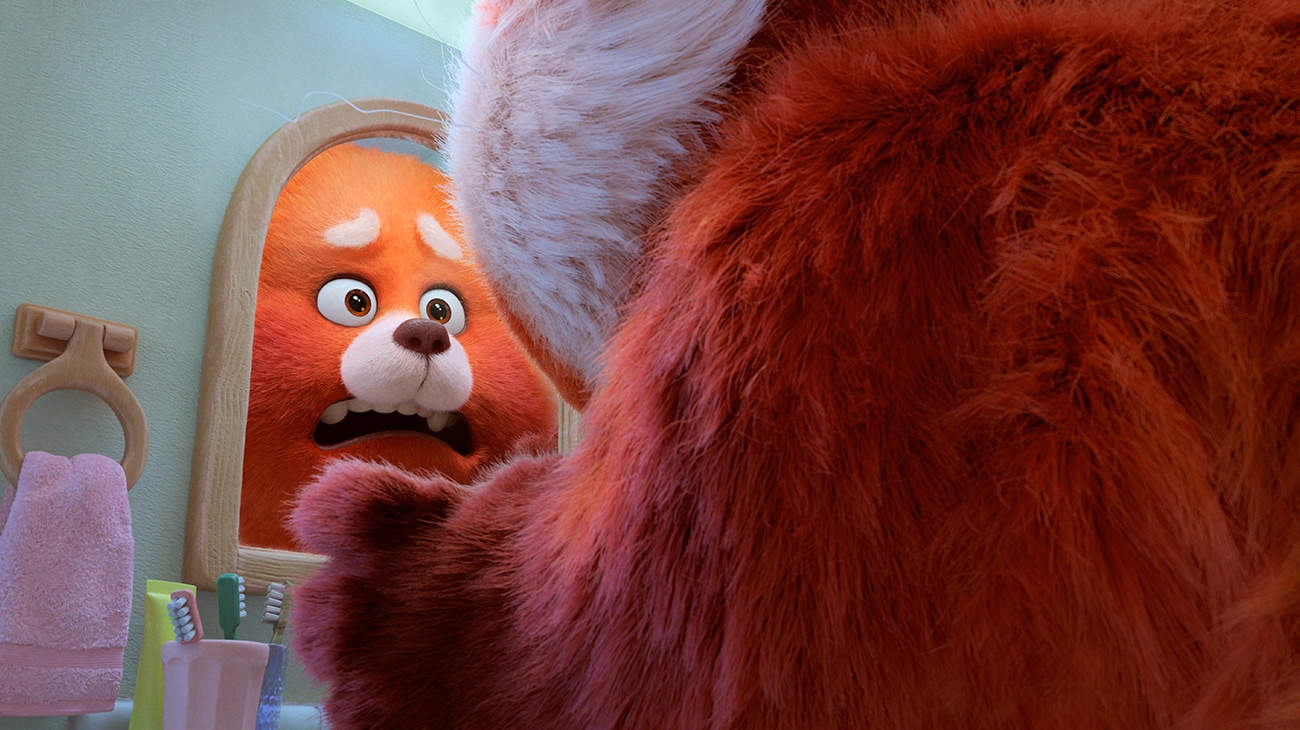If the first thing you hear about a piece of art is that it’s relatable—run. Relatability is a euphemism used by business people in the arts for we know this will make money, because it’s made money before. Relatability is not art, it’s commerce. I am trying to sell a book right now and the big concern is comps—comparable books that have done well. My question is: Why would I bother writing a book if it’s already been written? Artists want to make the opposite of comps. It’s why they are so bad at business. And vice versa: It’s why business is so bad at art.
Turning Red is not really meant for someone like me. First of all, it’s animated, and I tend to avoid animated movies. (I know, I get shit for it all the time.) It’s also basically a puberty movie for kids. And I’m not a kid. But I kept hearing about it. If you’re in Toronto, you can’t really avoid it. It’s one of the rare movies in which this city, where so many movies are filmed, is not repackaged as some generic American alternative (for relatability, of course). It’s so rare to see Toronto allowed to actually be Toronto—from the CN Tower to the SkyDome to the city’s particular electricity boxes—that my friend’s initial reaction was, “She must have fought for that.” Whether or not she (director Domee Shi) did in that particular case, she has been open about feeling like she had to sneak Turning Red into the system. “How do I sell this and get old white men who’ve never experienced this before excited about this and wanting to, like, see more of it?” was what she thought, she told The New York Times, before one pitch meeting with senior Disney execs. This is a woman who won an Oscar in 2019 (Best Animated Short, Bao), for God’s sake!!! But she is also the first woman in the Disney-owned Pixar studio’s 36-year history to direct a movie solo. Which is to say, whether her comps were Teen Wolf and Ghostbusters or not, whether we all go through puberty or not, whether or not we all have overbearing parents or best friends who help us handle it, Shi’s “Asian tween fever dream” was never going to be a sure thing.
As much as relatability is about commerce, it’s also about the people who power that commerce: white men. It’s about what they gravitate towards with their very specific white-men experiences—not just professionally (as in what has done well), but personally (as in what they know directly)—and what they think everyone else will gravitate towards, which is to say, all things white and male. The world population can be majority Asian (it is), it can be majority women (it isn’t), and, still, because the people making decisions in Hollywood are not those people, they will not be the target audience.
This has created an entertainment ecosystem in which the standard has become white and male, even though the standard has never actually been white and male. Which is how you get the messy Turning Red review by Sean O’Connell at CinemaBlend, whose bio reads, “a movie junkie who’s infatuated with comic-book films. Helped get the Snyder Cut released, then wrote a book about it” (the parodies write themselves these days). O’Connell cited The Mitchells vs. The Machines—a movie written and directed by men about a family saving the world from a robot uprising—as identifiable for a universal audience in the way a “mystical red panda” was not. “I recognized the humor in the film, but connected with none of it,” he wrote. “By rooting Turning Red very specifically in the Asian community of Toronto, the film legitimately feels like it was made for Domee Shi’s friends and immediate family members. Which is fine — but also, a tad limiting in its scope.” CinemaBlend’s editor in chief eventually pulled the review and apologized for failing to properly edit it.
Considering his affinity for robots, I imagine O’Connell was more drawn to After Yang, which is also very much my shit. Kogonada’s contemplative drama, set in a lush future-scape, has a family grappling with the “death” of their child’s robot sibling. The reason I bring up this film is because one of its main themes is the limits (or lack thereof) of human relatability. Instead of being a story about a robot’s quest to become human—Yang seems more inquisitive about his Asian-ness—it is a story about a human’s quest to connect with the very full life this robot led (while attempting to fix Yang, his “father” has the robot’s memory extracted, and a constellation of experiences appear that construct a previously unknown life). It reminded me of Andrea Arnold’s upcoming documentary Cow, in which she quietly observed a dairy cow in the final years of its life without anthropomorphizing it. The British filmmaker simply connected to the cow as another being, sharing its experience without imposing her humanity onto it.
Which is not to say that one’s humanity does not dictate one’s response. While I was fully aware of the Asian perspective in After Yang, I was more conscious of my gravitation towards the themes of grief and memory. But the richness of the story, and Kogonada’s handling of it, means there are multiple ports of connection. As Leo Kim writes at Polygon, after noting the film’s unconventionality, “Kogonada deliberately subverts the tropes and mechanics we’ve come to expect, using them as jumping-off points to respond to the sci-fi genre’s dark legacy of Orientalism and the dehumanization of Asian people.” This reminds me of something sociologist Nancy Wang Yuen (author of Reel Inequality: Hollywood Actors and Racism) said in an NPR interview about the Turning Red review debacle. “Even when you are the center of a story, I can’t possibly relate to you because you’re not human,” she said. “That’s what it kind of felt like.” After Yang argues that even different species—Yang is a “techno-sapien”—command more empathy than some people seem willing to give their fellow man.
It’s unsurprising that the current iteration of relatability came out of the TV industry in the ’80s in order to gauge how successful a quiz show could be. As Jeremy D. Larson wrote in the New York Times Magazine in 2019, “Relatability measures how strange something isn’t, the lack of mystery itself.” He notes that it is now so pervasive it is itself alien. But the social aspects—that desire for connection—and aforementioned financial implications of the term also fold neatly into a megacorporation’s franchise—like The Batman, say—or even a lucrative generic tear-jerker like CODA, in the era of social media.
The assumption that something completely foreign to you couldn’t somehow be legible to you shouldn’t have to be disproven, but it has been time and again, most recently by the success of Drive My Car, which has claimed comparisons to Parasite for its surprise Hollywood awards season sweep (even though the only real “comp” here is that the former was reportedly supposed to take place in South Korea before Covid relocated it to Japan). This is a three-hour meditation on a short story by Japanese author Haruki Murakami by Japanese director Ryusuke Hamaguchi about a theater director of a multilingual production of the Russian play Uncle Vanya as the director grieves over the death of his wife and befriends his driver, who has her own baggage. A lot of it takes place in a car. Hamaguchi has explained that this isn’t your average adaptation from page to screen—it is itself a form of translation, his own feelings and emotions informing what ultimately appears on screen. “It’s not that I’m borrowing the text itself or even the content of the story, but I’m adapting my own experience of reading the work and attempting to share that with the audience,” he told Screen Slate. “It’s like I’m using myself as a conversion device.” It’s the kind of connection anyone can understand, you would hope, no matter who they are.







